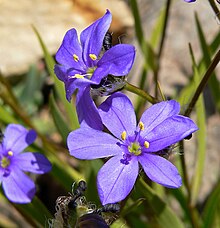bio.wikisort.org - Plantae
Le Iridacee (Iridaceae Juss., 1789) sono una famiglia di piante erbacee monocotiledoni dell'ordine Asparagales comprendente circa 1 800 specie in 69 generi[1][2]. La famiglia è originaria delle regioni tropicali dell'Africa meridionale e dell'America centrale e meridionale, ma è diffusa anche nelle regioni temperate. In Italia, crescono spontanee una cinquantina di specie comprese in cinque generi.
| Iridaceae | |
|---|---|
 | |
| Classificazione APG IV | |
| Dominio | Eukaryota |
| Regno | Plantae |
| (clade) | Angiosperme |
| (clade) | Mesangiosperme |
| (clade) | Monocotiledoni |
| Ordine | Asparagales |
| Famiglia | Iridaceae Juss., 1789 |
| Classificazione Cronquist | |
| Dominio | Eukaryota |
| Regno | Plantae |
| Divisione | Magnoliophyta |
| Classe | Liliopsida |
| Ordine | Liliales |
| Famiglia | Iridaceae |
| Sottofamiglie | |
| |
Le Iridacee traggono il loro nome dal genere Iris.
Descrizione
Le Iridacee sono piante erbacee perenni dotate di rizomi, bulbi o bulbo-tuberi, con fusti semplici o ramificati. Le foglie sono lineari o appuntite all'estremità, inguainanti, a margine intero, parallelinervie.
I fiori sono vistosi, avvolti da giovani in una spata con 2 o più brattee, con perigonio a 6 tepali saldati nella parte inferiore o formanti un tubo più o meno lungo allargato nella parte terminale. L'ovario è costituito da tre logge contenenti molti ovuli. I fiori sono talvolta solitari (ad esempio nel genere Crocus) o, più di frequente, raccolti in infiorescenze terminali, a forma di spighe, racemi, o cime, frutti a capsula con molti semi solitamente di forma allungata. Ma il carattere fondamentale che distingue le Iridacee dalle affini Amaryllidacee è la presenza di soli 3 stami, contro 6 nella seconda famiglia.
Tassonomia

Le analisi filogenetiche basate sulla morfologia e sulla sequenza del DNA indicano che le Iridacee costituiscono un clade monofiletico.[3][4][5][6][7]
Il Sistema Cronquist collocava tradizionalmente le Iridacee all'interno dell'ordine Liliales[8][9], mentre la moderna classificazione filogenetica la colloca nell'ordine Asparagales.[2]
La famiglia Iridacee comprende le seguenti sottofamiglie e tribù:[3][4][7][10][11][12][13]
- sottofamiglia Aristeoideae
- sottofamiglia Crocoideae
- tribù Freesieae
- tribù Gladioleae
- tribù Ixieae
- tribù Tritoniopsideae
- tribù Watsonieae
- sottofamiglia Geosiridoideae
- sottofamiglia Iridoideae
- tribù Diplarreneae
- tribù Irideae
- tribù Sisyrinchieae
- tribù Tigridieae
- tribù Trimezieae
- sottofamiglia Isophysidoideae
- sottofamiglia Nivenioideae
- sottofamiglia Patersonioideae
Generi
La famiglia comprende i seguenti generi:[1]
- Afrosolen Goldblatt & J.C.Manning
- Alophia Herb.
- Aristea Aiton
- Babiana Ker Gawl.
- Bobartia L.
- Calydorea Herb.
- Chasmanthe N.E.Br.
- Cipura Aubl.
- Cobana Ravenna
- Codonorhiza Goldblatt & J.C.Manning
- Crocosmia Planch.
- Crocus L.
- Cyanixia Goldblatt & J.C.Manning
- Cypella
- Deluciris A.Gil & Lovo
- Devia Goldblatt & J.C.Manning
- Dierama K.Koch
- Dietes Salisb. ex Klatt
- Diplarrena Labill.
- Duthiastrum M.P.de Vos
- Eleutherine Herb.
- Ennealophus N.E.Br.
- Ferraria Burm. ex Mill.
- Freesia Eckl. ex Klatt
- Geissorhiza Ker Gawl.
- Gelasine Herb.
- Geosiris Baill.
- Gladiolus Tourn. ex L.
- Herbertia Sweet
- Hesperantha Ker Gawl.
- Hesperoxiphion Baker
- Iris Tourn. ex L.
- Isophysis T.Moore
- Ixia L.
- Klattia Baker
- Lapeirousia Pourr.
- Larentia Klatt
- Lethia Ravenna
- Libertia Spreng.
- Mastigostyla I.M.Johnst.
- Melasphaerula Ker Gawl.
- Micranthus (Pers.) Eckl.
- Moraea Mill.
- Nemastylis Nutt.
- Nivenia Vent.
- Olsynium Raf.
- Orthrosanthus Sweet
- Patersonia R.Br.
- Phalocallis Herb.
- Pillansia L.Bolus
- Radinosiphon N.E.Br.
- Romulea Maratti
- Salpingostylis Small
- Savannosiphon Goldblatt & Marais
- Schizorhiza Goldblatt & J.C.Manning
- Sisyrinchium L.
- Solenomelus Miers
- Sparaxis Ker Gawl.
- Syringodea Hook.f.
- Tapeinia Comm. ex Juss.
- Thereianthus G.J.Lewis
- Tigridia Juss.
- Trimezia Salisb. ex Herb.
- Tritonia Ker Gawl.
- Tritoniopsis L.Bolus
- Watsonia Mill.
- Witsenia Thunb.
- Xenoscapa (Goldblatt) Goldblatt & J.C.Manning
- Zygotritonia Mildbr.
Alcune specie
- Moraea viscaria, una specie africana. La varietà dei fiori delle Iridacee è una conseguenza del loro adattamento a differenti specie di impollinatori.
- Un fiore di Sisyrinchium bellum; in questa specie, le due spirali dei tepali sono identiche.
- Neomarica northiana è una specie che presenta ampie differenze di colore e forma tra le spirali dei tepali.
- Watsonia pyramidata, si noti la corolla tubulare.
- Gladiolus illyricus, una specie europea che mostra dei fiori zigomorfici (bilateralmente simmetrici).
- Infiorescenza di Ixia dubia.
- Una cultivar di Crocus vernus.
- Sparaxis tricolor è coltivata in tutto il mondo come pianta ornamentale.
- Tigridia pavonia, un'iridacea del Messico coltivata come pianta ornamentale.
Usi
Le I. sono utilizzate in fitoterapia (Aletris, Iris), profumeria (Iris), in cucina o tintoria (Crocus, Iris, Moraea, Gladiolus, Tigridia), o come piante ornamentali (Iris, Gladiolus, Freesia, Ixia, Crocus, Sparaxis, Crocosmia, etc.)
Note
- (EN) Iridaceae, su Plants of the World Online, Royal Botanic Gardens, Kew. URL consultato il 18/7/2021.
- (EN) The Angiosperm Phylogeny Group, An update of the Angiosperm Phylogeny Group classification for the ordines and families of flowering plants: APG IV, in Botanical Journal of the Linnean Society, vol. 181, n. 1, 2016, pp. 1–20.
- Goldblatt, P. (1990). Phylogeny and classification of Iridaceae. Ann. Missouri Bot. Gard. (77): pp. 607-627.
- Rudall, P. (1994). Anatomy and systematics of Iridaceae. Bot. J. Linn. Soc. (114): pp. 1-21.
- Chase M. W., Duvall, M. R., Hills, H. G., Conran, J. G., Cox, A. V., Eguiarte, L. E., Hartwell, J., Fay, M. F., Caddick, L. R., Cameron, K. M., Hoot, S., Molecular systematics of Lilianae. In Rudall, P. J., Cribb, P. J., Cutler, D. F., Monocotyledons: Systematics and evolution, Royal Botanic Gardens, Kew, 1995, pag. 109-137
- Chase M. W., Soltis, D. E., Soltis, P. S., Rudall, P. J., Fay, M. F., Hahn, W. H., Sullivan, S., Joseph, J., Molvray, M., Kores, P. J., Givnish, T. J., Sytsma, K. J., y Pires, J. C., Higher-level systematics of the monocotyledons: An assessment of current knowledge and a new classification. In Wilson, K. L. y Morrison, D. A., Monocots: Systematics and evolution., CSIRO Publ., 2000, Collingwood, Australia, pag. 3-16
- Reeves, P. A.; Chase, M. W., Goldblatt, P., Rudall, P., Fay, M. F., Cox, A. V., Lejeune, B., Souza-Chies, T. (2001). Molecular systematics of Iridaceae: evidence from four plastid DNA regions. Amer. J. Bot. (88): pp. 2074-2087.
- Stevenson D. W., Loconte, H., Cladistic analysis of monocot families. In Rudall, P. J., Cribb, P. J., Cutler, D. F., Monocotyledons: Systematics and evolution. Royal Botanic Gardens, Kew, 1995, pag.543-578
- Chase M. W., Stevenson, D. W., Wilkin, P., y Rudall, P. J., Monocot systematics: A combined analysis. In Rudall, P. J., Cribb, P. J., Cutler, D. F., Monocotyledons: Systematics and evolution., Royal Botanic Gardens, Kew, 1995b, pag. 685-730
- Goldblatt, P. (1991). An overview of the systematics, phylogeny and biology of the southern African Iridaceae. Contr. Bolus Herb. 13: pp. 1–74.
- Goldblatt, P.; Manning, J. C., Rudall, P. (1998). Iridaceae. In Kubitzki, K.. The families and genera of vascular plants, vol 3, Monocotyledons: Lilianae (except Orchidaceae). (Royal Botanic Gardens edición). Berlin: Springer-Verlag. pp. 181-200.
- Goldblatt, P.; V. Savolainen, O Porteous, Y Sostaric, M. Powell, G. Reeves, J. C. Manning, T. G. Arraclough. (2002). Radiation in the Cape flora and the phylogeny of peacock irises Moraea (Iridaceae) based on four plastid DNA regions. Molecular Phylogenetics and Evolution 25: pp. 341-360.
- (EN) Iridaceae, su Angiosperm Phylogeny Website. URL consultato il 27/7/2021.
Voci correlate
- Giardinaggio
- Floricoltura
- Pianta ornamentale
- Pianta medicinale
- Pianta officinale
- Specie botaniche in Italia
Altri progetti
 Wikimedia Commons contiene immagini o altri file su Iridaceae
Wikimedia Commons contiene immagini o altri file su Iridaceae Wikispecies contiene informazioni su Iridaceae
Wikispecies contiene informazioni su Iridaceae
Collegamenti esterni
- Iridacee, su Treccani.it – Enciclopedie on line, Istituto dell'Enciclopedia Italiana.
- (EN) Iridaceae, su Enciclopedia Britannica, Encyclopædia Britannica, Inc.
- (EN) Iridaceae, su Fossilworks.org.
- Bulbsociety, su bulbsociety.org.
| Controllo di autorità | Thesaurus BNCF 34986 · LCCN (EN) sh85068064 · BNF (FR) cb119785923 (data) · J9U (EN, HE) 987007560422705171 · NDL (EN, JA) 00560416 |
|---|
На других языках
[es] Iridaceae
Las iridáceas (Iridaceae) son una familia de plantas perennes, herbáceas y bulbosas pertenecientes al orden Asparagales dentro de las monocotiledóneas. La familia, cuyo nombre deriva del género Iris, cuenta con más de 2000 especies que se distribuyen por casi todo el mundo, siendo una de las familias más importantes en horticultura. Géneros tales como Crocus e Iris son componentes preponderantes de las floras de varias regiones de Eurasia e Iris se halla muy bien representado en Norte América. Gladiolus y Moraea son géneros muy amplios y componentes principales de la flora subsahariana y sudafricana. Sisyrinchium, con más de 140 especies, es el género de iridáceas más diversificado en América, donde también se encuentran varios otros miembros de la familia, muchos de los cuales son importantes en la floricultura tropical.[1]- [it] Iridaceae
[ru] Ирисовые
И́рисовые, или Каса́тиковые (лат. Iridáceae) — довольно значительное по количеству родов растений семейство порядка Спаржецветные. Оно состоит исключительно из многолетних травянистых форм с весьма разнообразно устроенными корневищами.Другой контент может иметь иную лицензию. Перед использованием материалов сайта WikiSort.org внимательно изучите правила лицензирования конкретных элементов наполнения сайта.
WikiSort.org - проект по пересортировке и дополнению контента Википедии









